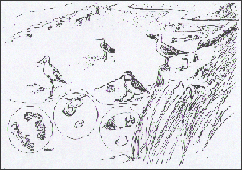| |
|
Mudflats and Sandy Beaches 
Mudflats and sandy beaches are important shorebird habitat. They can occur inland, but sandy beaches especially are found in the intertidal zone along the ocean shores. Mudflats are made of differently sized particles than those composing sandy beaches. Inland they can occur around inland lakes and rivers. What do coastal mudflats and sandy beaches have in common besides the tide? They are both very open habitats with few plants but often rich in invertebrate prey.
Organisms that can adapt to conditions of periodic wetness and salinity changes do well because there are lots of nutrients in these mudflat and beach habitats. These elements are carried down by rivers and mix with nutrients from the ocean or lake. Such wetlands, especially in coastal areas, are some of the most productive (maker of food) areas on the earth. If you scooped up one pail of mud or sand from the beach below the high water mark and examined it with a microscope, you would see hundreds or thousands of tiny snails, worms, and invertebrate eggs and larva. There would be larger animals like clams and long worms as well. There are millions of clams, shrimp, and worms buried in the mud and sand in intertidal mudflat and sandy beach zones.
The flight path for millions of migrating shorebirds follows the shoreline as they move north in spring or south in fall. The birds need a lot of energy-rich food to fly thousands of miles. Their next stop might be hundreds or thousands of miles away.
  |
|
|
|
